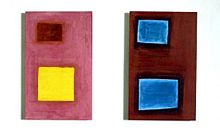Michael Growe
Michael Growe (born January 12, 1960 in Warburg ) is a German painter, sculptor and object artist. He studied at the Düsseldorf Art Academy from 1983 to 1989 , and in 1989 he became a master class student. His teachers included Gotthard Graubner , Erwin Heerich and his brother, the art historian Bernd Growe. He lives in Cologne and has been running his studio since 1996 at the Hombroich rocket station , Stiftung Insel Hombroich in Neuss.
Work and artistic development
Clear influences in Growe's work come from the New York School ( Hans Hofmann , Ellsworth Kelly , Ad Reinhardt and others) and the European Informel ( Group 53 and others) - his works are often characterized by intense colors that visualize the contrast between surface and space multi-layered color field painting. Typical of his work - in addition to the abstract, expressive painting gesture - is the wooden chassis as the image carrier .
“Awareness of spatial and temporal dimensions in artistic work is one of the primary goals. (...) For Growe, painting always means the creation of a body born out of color, which receives a special 'charge' through the 'way in which the paint is applied' and through the 'organization of the colors' ... "
“This conception, which culminates in the idea of color as a three-dimensional form that affects space, removes the boundary between fictional and factual spatiality, since the image is now perceived in its three-dimensional form. Michael Growe now seems to increase this approach and lets the picture not only take on the volume of a piece of furniture, but also take on its function as a commodity. On the basis of minimalist discourses, Growe not only experiences the transition from fictionality to facticity , but also to functionality ”.
Growe describes the facticity of the effect and charisma of his painting as a color charge . This feeling that the surface is charged is achieved through a special procedure in the application of paint. An elaborate technique in which the wood is repeatedly painted with hide glue and sanded in many layers creates a soft but structured depth. Through the cut, Michael Growe penetrates and opens the layers of paint lying on top of one another and in this way makes the processual aspect of his painting tangible. Michael Growe's painting experiences a new dimension in his architecture-related painting: the color on his objects and sculptures, the so-called “Trojans”, carries its load into real space by means of its three-dimensional expansion.
Working in public space
- Aachen, museum in the former imperial abbey Kornelimünster .
- Düsseldorf, Museum Kunstpalast
- Frankfurt, Deutsche Bank
- Frankfurt, KFW banking group
- Kaiserslautern, Museum Pfalz-Galerie
- Kleve, Kurhaus Museum
- Cologne, Museum of Applied Arts
- Cologne, Oppenheim Bank
- Cologne, Stadtsparkasse
- Krefeld, German Textile Museum
- Krefeld, Volksbank
- Mülheim an der Ruhr, art museum
- Munich, Bavarian Hypo-Bank
- Neuss, Museum Insel Hombroich.
Exhibitions
Michael Growe's works have been exhibited in Germany (including the Städtische Kunsthalle Düsseldorf, Kunstverein Münsterland, Museum of Applied Arts in Cologne), Italy, France, Lithuania, Switzerland and China (including the Beijing International Art Biennale ). In 2003 Michael Growe was awarded the Münsterland Art Prize by the Münsterland Art Association. In 2006 he realized the stage design for the music theater "WIR" by Christoph Staude based on Evgeni Iwanowitsch Samjatin as part of the "International Festival for New Music Theater" biennial in Munich (2006).
literature
- Pictures, Michael Growe. Bochum 1988.
- Pictures / pieces, Michael Growe. Ed. Museumsverein Warburg e. V. Warburg 1991.
- "Rebis", Michael Growe. 1992 With texts by Justus Jonas and Guido de Werd
- "Andres Bally, Michael Growe" With texts by Holger Bröker and Thomas Kling Kunstverein Braunschweig 1998
- "Augenweide / Wolkensteno", library Schlandersburg 2000. Text: Ursula Sinnreich.
- "Zikkurat", Pfalzgalerie Kaiserslautern, Kunstverein Münsterland, 2001. Texts by Martin Gesing, Uwe Schramm and Britta E. Buhlmann
- "Spaceships", published by Kunstverein Unna. Unna 2004. With a text by Claudia Posca
- “Cadavre Exquis”, Münster 2007. With a text by Erich Franz.
- “Week on the shelf”, Krefeld 2007. With a text by Reinhard Hoeps.
- “Trojaner”, Villa Goecke, Krefeld, Bönen 2010. With a text by Bettina Deschler.
- “Awakening painting and real space”, Bochum 2011. Wunderhorn Verlag 2011.
Web links
Individual evidence
- ^ Uwe Schramm: Space Oddity. In: Michael Growe: Ziggurat . DruckVerlag Kettler, 2001/2002
- ↑ Bettina Deschler: The cupboard is a picture. In: Michael Growe: Trojan. Villa Goecke, ARTAX, 2010
- ↑ General Artist Lexicon , Volume 63, Leipzig and Munich 2009, p. 272.
- ↑ General Artist Lexicon , Volume 63, Leipzig and Munich 2009, p. 272.
| personal data | |
|---|---|
| SURNAME | Growe, Michael |
| BRIEF DESCRIPTION | German painter, sculptor and object artist |
| DATE OF BIRTH | January 12, 1960 |
| PLACE OF BIRTH | Warburg |



